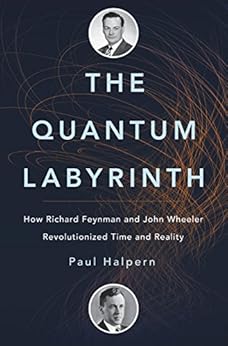 |
| Amazon link |
Paul Halpern, a physicist and historian of science, has written here a combined biography of John Wheeler and Richard Feynman covering the fifty years of their interlinked careers in physics (c. 1940-1990). Feynman started out as a student of Wheeler's, working on the deep problems of Dirac's early formulation of quantum electrodynamics, specifically 'the infinities'. Wheeler and Feynman resurrected the old Newtonian idea of 'action at a distance', combining advanced and retarded solutions of Maxwell's equations to model radiation resistance. This led to Feynman's development of the path integral formalism.
The war diverted both of them to the Manhattan project - Feynman's war in particular has been amply covered in many other books, together with his doomed marriage to Arline.
Post-war we see the full-on assault on QED where Feynman diagrams make their appearance, we accompany Wheeler as he makes General Relativity relevant again, and we encounter topics as diverse as cosmology, the Everett interpretation of quantum mechanics, time travel, nanotechnology and quantum computing.
To read this book is to journey with the protagonists. It's strong on places and times, on personalities and issues and debates. There are no equations or diagrams, although Halpern has a talent for verbal description (he makes a reasonable job of describing delayed-choice experiments, for example).
If you're a physics graduate who has absorbed the abstractions as a logical edifice, you will find this book an ideal complement as you watch the builders debating models and shooting each other down, while racing for priority. They say you should never watch sausages being made, but in physics it adds that vital human dimension of context and motivation.
No comments:
Post a Comment
Comments are moderated. Keep it polite and no gratuitous links to your business website - we're not a billboard here.